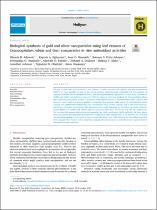Biological synthesis of gold and silver nanoparticles using leaf extracts of Crassocephalum rubens and their comparative in vitro antioxidant activities
Date
2020Author
Adewale, Olusola B.
Egbeyemi, Kayode A.
Fadaka, Adewale O.
Metadata
Show full item recordAbstract
The use of plant and plant products in the synthesis of silver nanoparticles (AgNPs) and gold nanoparticles
(AuNPs) is made possible because of the natural inherent phytochemicals responsible for the reduction of
respective metallic salts to nanoparticle forms, and ensuring therapeutic applicability. In this study, synthesis of
AgNPs and AuNPs was performed using two different aqueous extraction methods for Crassocephalum rubens:
maceration using laboratory method of extraction (cold aqueous extract of Crassocephalum rubens (AECR)), and
decoction using traditional healer's method of extraction (hot aqueous crude extract of Crassocephalum rubens
(CECR)). The synthesized nanoparticles were characterized using various methods, and in vitro antioxidant po-
tential were thereafter investigated. The characterization results indicated the formation of mostly spherical-
shaped AgNPs and AuNPs with surface plasmon resonance (SPR) band of 470 nm and 540 nm, respectively.
The nanoparticles possess high antioxidant potentials but AECR synthesized AuNPs exhibited the least phyto-
chemical contents and antioxidant potential when compared to other nanoparticles. It can therefore be concluded
that extraction method and nanoparticle type are important factors that could influence the antioxidant properties
of the nanoparticles. Further studies using these nanoparticles as anticancer or anti-inflammatory agent in both in
vitro and in vivo are underway.

